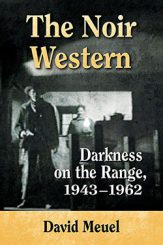By now, there are many excellent books on film noir, even on specific themes, locations, eras and countries. However, at least one major theme (or sub genre) has escaped the authors so far. The noir experience in America’s probably oldest and unique (usually most optimistic in outlook) movie tradition, the western, has not yet been the topic of an entire study.
 Those noir westerns display the dark sides of the American experience, and instead of the rainy and dimly lit streets of the city, a typical environment of film noir, the westerns portray nature, landscapes and even the usually iconic and hailed frontiersmen in their worst, most unforgiving and brutal ways.
Those noir westerns display the dark sides of the American experience, and instead of the rainy and dimly lit streets of the city, a typical environment of film noir, the westerns portray nature, landscapes and even the usually iconic and hailed frontiersmen in their worst, most unforgiving and brutal ways.
Many famous directors of noir classics also shot westerns, although these were usually less successful and forgotten over time. Noir’s classic era, roughly from 1941 until the early 1960s, with its sharp black & white contrasts, unusual camera angles, deeply psychological themes, and characters most reckless at that time, finally dramatically changed the western.
Starting in the late 1890s the western was one of the earliest genres people watched as silent movies at the cinema – partly because there were just a few major plot elements and also because the myth of the West, heroic stories of flamboyant frontiersmen and outlaws were only beginning to flourish. (While many of the featured historical characters such as Sitting Bull or Wyatt Earp were actually still alive.)
And when in 1947 the movies Pursued (by Raoul Walsh) and Ramrod (Andre de Toth) were released, noir film making had eventually taken over the western. A new sub genre was well on its way: the noir western (also referred to by others as western noir, existential western, Freudian western, sagebrush noir or Superwestern.)
Stimulated by the horrors of WWII, the new sub genre of the dark and sinister western seemingly attacked and challenged its traditional ancestor. Where nature represented peaceful living, beautiful landscapes and open space suggested never-ending stretches of unsettled land, opportunities and very positive sentiments about life, the noir western displayed evil, violence and the tormented pasts of its main characters who,by now, also populated those once beautiful grounds and open spaces.
However, the noir western was quite successful, even if it ended the “era of innocence” in movie making. Meuel suggests the year 1962, when noir western production come to a major stop, with the release of Ford’s The Man who Shot Liberty Valance and Sam Peckinpah’s Ride the High Country, for the theme of both movies is the end of the West, or the end of its myth and promise. Furthermore, Meuel, a movie buff and writer from California, sees the retirement of many great western directors as another reason for the end of that period. While, naturally, even after 1962 western movies were shot, the heyday of the genre was over.
One of noir’s main themes, the impossibility of escaping one’s past, terrifying dreams and deep pain that make the present unbearable, exists in the noir western too. Due to the large number off noir westerns and directors, Meuel concentrates on just a handful of directors and their work. Some names are famous, others mostly forgotten today: Raoul Walsh, Andre de Toth, William Wellmann, Delmer Daves, John Ford, Budd Boettcher, Allan Dwan, Anthony Mann, Henry King, Robert Wise, and Sam Fuller.
There is a short but very good chapter on Ford’s The Man who Shot Liberty Valance; not really a movie unknown, but the analysis of the many techniques and effects typical for noir movies it has truly surprises.
Meuel finally sees proof that noirish elements in the western, once just another way of showing a different picture of the west, eventually took over, in a way, and more or less dominated the mood and overall environment of most of the modern western (those shot roughly after 2007.) There is a list of fifty other noir westerns appended, most of them rare or very obscure. (Movie collectors – including myself – will appreciate this kind of “Easter egg,” since it actually does help individual research a lot.)
And if Meuel’s guess is correct, we will see more of noir’s heritage in future science fiction, action, superhero movies and other genres.
Review by Dr. A. Ebert © 2016
David Meuel. The Noir Western: Darkness on the Range 1943-1962. McFarland, 2015, 220 p.
